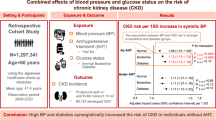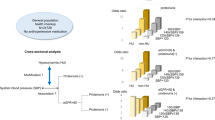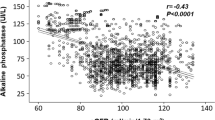Abstract
The prevalence of renal insufficiency in hypertensive participants without comorbidities affecting renal function is unknown. The objective of this study was to assess the prevalence and predictors of renal insufficiency in general hypertensive population. We examined 994 hypertensive participants aged 45–70 years without previously diagnosed diabetes, cardiovascular disease or chronic kidney disease. Renal insufficiency was defined as estimated glomerular filtration rate <60 ml min−1 per 1.73 m2 by the Modification of Diet in Renal Disease formula. The metabolic syndrome was defined according to the International Diabetes Federation and the US National Cholesterol Education Program Third Adult Treatment Panel criteria. Glucose homoeostasis was assessed with an oral glucose tolerance test. The prevalence of renal insufficiency was 6.7% (95% confidence interval (CI) 5.3–8.5). In a multivariate model, the presence of renal insufficiency was predicted by female gender (odds ratio (OR) 3.57 (95% CI 1.90–6.72)), older age (OR 1.13 (95% CI 1.07–1.18)), use of diuretics (OR 2.13 (95% CI 1.19–3.82)) and metabolic syndrome (OR 2.79 (95% CI 1.34–5.79)). Newly diagnosed diabetes or prediabetes did not predict renal insufficiency. The prevalence of renal insufficiency was found to be lower than previously reported in hypertensive general population. Metabolic syndrome, but not newly diagnosed diabetes or prediabetes per se, was strongly associated with renal insufficiency especially in women. Renal insufficiency was also associated with the use of diuretics, but the clinical relevance of this finding needs to be clarified.
This is a preview of subscription content, access via your institution
Access options
Subscribe to this journal
Receive 12 digital issues and online access to articles
$119.00 per year
only $9.92 per issue
Buy this article
- Purchase on Springer Link
- Instant access to full article PDF
Prices may be subject to local taxes which are calculated during checkout
Similar content being viewed by others
References
Henry RMA, Kostense PJ, Bos G, Dekker JM, Nijpels G, Heine R et al. Mild renal insufficiency is associated with increased cardiovascular mortality: The Hoorn Study. Kidney Int 2002; 62: 1402–1407.
Manjunath G, Tighiouart H, Ibrahim H, MacLeod B, Salem DN, Griffith JL et al. Level of kidney function as a risk factor for atherosclerotic cardiovascular outcomes in the community. J Am Coll Cardiol 2003; 41: 47–55.
Culleton BF, Larson MG, Wilson PWF, Evans JC, Parfrey PS, Levy D . Cardiovascular disease and mortality in a community-based cohort with mild renal insufficiency. Kidney Int 1999; 56: 2214–2219.
Cockcroft DW, Gault MH . Prediction of creatinine clearance from serum creatinine. Nephron 1976; 16: 31–41.
Levey AS, Greene T, Kusek JW, Beck GJ . A simplified equation to predict glomerular filtration rate from serum creatinine. J Am Soc Nephrol 2000; 11: A0828.
Levey AS, Coresh J, Balk E, Kausz AT, Levin A, Steffes MW et al. National Kidney Foundation Practice Guidelines for Chronic Kidney Disease: evaluation, classification, and stratification. Ann Intern Med 2003; 139: 137–147.
Levey AS, Eckardt KA, Tsukamoto Y, Levin A, Coresh J, Rossert J et al. Definition and classification of chronic kidney disease: a position statement from kidney disease: improving global outcomes (KDIGO). Kidney Int 2005; 67: 2089–2100.
The Task Force for the Management of Arterial Hypertension of the European Society of Hypertension (ESH) and of the European Society of Cardiology (ESC). 2007 Guidelines for the management of arterial hypertension. J Hypertens 2007; 25: 1105–1187.
Lindström J, Tuomilehto J . The diabetes risk score: a practical tool to predict type 2 diabetes risk. Diabetes Care 2003; 26: 725–731.
Levey AS, Coresh J, Greene T, Marsh J, Stevens LA, Kusek J et al. Expressing the MDRD study equation for estimating GFR with IDMS traceable (gold standard) serum creatinine values. J Am Soc Nephrol 2005; 16: 69A.
World Health Organization: Definition and diagnosis of diabetes mellitus and intermediate hyperglycemia. Report of a WHO/IDF consultation. World Health Org.: Geneva, 2006.
Alberti KG, Zimmet P, Shaw J . IDF Epidemiology Task Force Consensus Group. The metabolic syndrome—a new worldwide definition. Lancet 2005; 366: 1059–1062.
Expert Panel on Detection, Evaluation, and Treatment of High Blood Cholesterol in Adults. Executive summary of The Third Report of The National Cholesterol Education Program (NCEP) expert panel on detection, evaluation, and treatment of high cholesterol in adults (Adult Treatment Panel III). JAMA 2001; 285: 2486–2497.
Gomez P, Ruilope LM, Barrios W, Navarro J, Prieto MA, Gonzalez O et al. Prevalence of renal insufficiency in individuals with hypertension and obesity/overweight: The FATH Study. J Am Soc Nephrol 2006; 17: S194–S200.
Redon J, Morales-Olivas F, Galgo A, Brito MA, Mediavilla J, Marín R et al. Urinary albumin excretion and glomerular filtration rate across the spectrum of glucose abnormalities in essential hypertension. J Am Soc Nephrol 2006; 17: S236–S245.
Quinn MP, Rainey A, Cairns KJ, Marshall AH, Savage G, Kee F et al. The practical implications of using standardized estimation equations in calculating the prevalence of chronic kidney disease. Nephrol Dial Transplant 2008; 23: 542–548.
Miller W, Myers G, Ashwood E, Killeen A, Wang E, Thienpont L et al. Creatinine measurement: state of the art in accuracy and interlaboratory harmonization. Arch Pathol Lab Med 2005; 129: 297–304.
Eriksen BO, Ingebretsen OC . In chronic kidney disease staging the use of the chronicity criterion affects prognosis and the rate of progression. Kidney Int 2007; 72: 1242–1248.
Redón J, Cea-Calvo L, Lozano JV, Fernández-Pérez C, Navarro J, Bomet A, et al., on behalf of the ERIC-HTA 2003 Study. Kidney function and cardiovascular disease in the hypertensive population: the ERIC-HTA study. J Hypertens 2006; 24: 663–669.
Rigalleau V, Lasseur C, Raffaitin C, Beauvieux M-C, Barthe N, Chauveau P et al. Normoalbuminuric renal-insufficient diabetic patients. Diabetes Care 2007; 30: 2034–2039.
Kramer CK, Leitao CB, Pinto LC, Silveiro SP, Gross JL, Canani LH . Clinical and laboratory profile of patients with type 2 diabetes with low glomerular filtration rate and normoalbuminuria. Diabetes Care 2007; 30: 1998–2000.
Chen J, Muntner P, Hamm L, Jones DW, Batuman V, Fonseca V et al. The metabolic syndrome and chronic kidney disease in US adults. Ann Intern Med 2004; 140: 167–174.
Nyengaard JR, Bendtsen TF . Glomerular number and size in relation to age, kidney weight, and body surface in normal man. Anat Rec 1992; 232: 194–201.
Hoy WE, Douglas-Denton RN, Hughson MD, Cass A, Johnson K, Bertram JF . A stereological study of glomerular number and volume: preliminary findings in a multiracial study of kidneys at autopsy. Kidney Int 2003; 63: 531–537.
Keller G, Zimmer G, Mall G, Ritz E, Amann K . Nephron number in patients with primary hypertension. N Engl J Med 2003; 348: 101–108.
Kurella M, Lo JC, Chertow GM . Metabolic syndrome and the risk for chronic kidney disease among nondiabetic adults. J Am Soc Nephrol 2005; 16: 2134–2140.
Klahr S, Levey AS, Beck GJ, Caggiula AW, Hunsicker L, Kusek JW, on behalf of the Modification of Diet in Renal Disease Study Group. The effects of dietary protein restriction and blood pressure control on the progression of chronic renal disease. N Engl J Med 1994; 330: 878–884.
Fletcher A, Amery A, Birgenhager W, Bulpitt C, Clement D, deLeeuw P et al. Risks and benefits in the trial of the European Working Party on High Blood Pressure in the Elderly. J Hypertens 1991; 9: 225–230.
Neaton JD, Grimm RH, Prineas RJ, Stamler J, Grandits GA, Elmer PJ et al. Treatment of Mild Hypertension Study Research Group. Treatment of Mild Hypertension Study: final results. JAMA 1993; 270: 713–724.
The ALLHAT Officers and Coordinators for the ALLHAT Collaborative Research Group. Major outcomes in high-risk hypertensive patients randomized to angiotensin converting enzyme inhibitor or calcium channel blocker vs diuretic: the Antihypertensive and Lipid-Lowering Treatment to Prevent Heart Attack Trial (ALLHAT). JAMA 2002; 288: 2981–2997.
de Leeuw PW, Ruilope LM, Palmer CR, Brown MJ, Castaigne A, Mancia G et al. Clinical significance of renal function in hypertensive patients at high risk. Arch Intern Med 2004; 164: 2459–2464.
Stedden S, Ashman N, Chesser A, Cunningham J . Oxford Handbook of Nephrology and Hypertension, Chapter 1, Oxford University Press: London, UK, 2006, 28.
Author information
Authors and Affiliations
Corresponding author
Rights and permissions
About this article
Cite this article
Korhonen, P., Aarnio, P., Vesalainen, R. et al. Hypertensive women with the metabolic syndrome are at risk of renal insufficiency more than men in general population. J Hum Hypertens 23, 97–104 (2009). https://doi.org/10.1038/jhh.2008.115
Received:
Revised:
Accepted:
Published:
Issue Date:
DOI: https://doi.org/10.1038/jhh.2008.115



